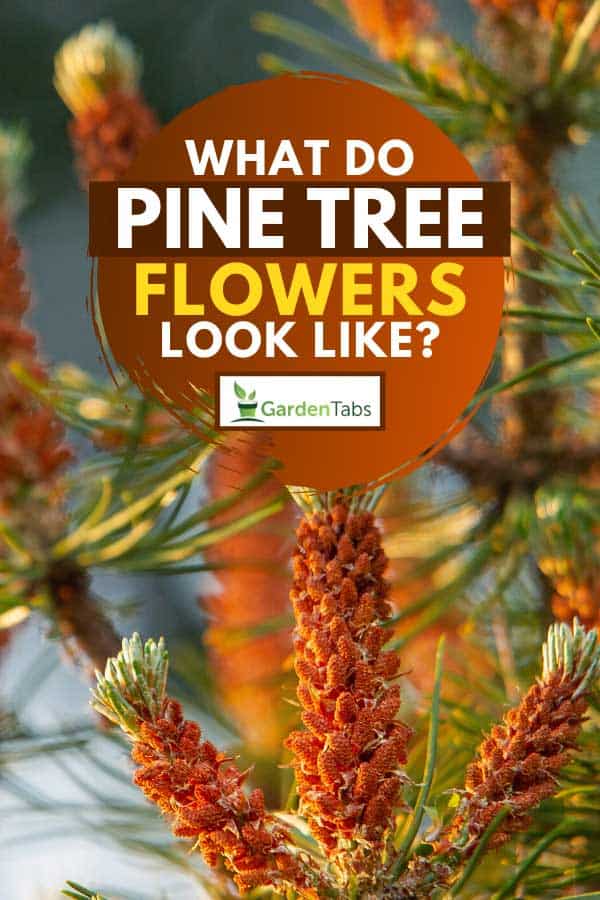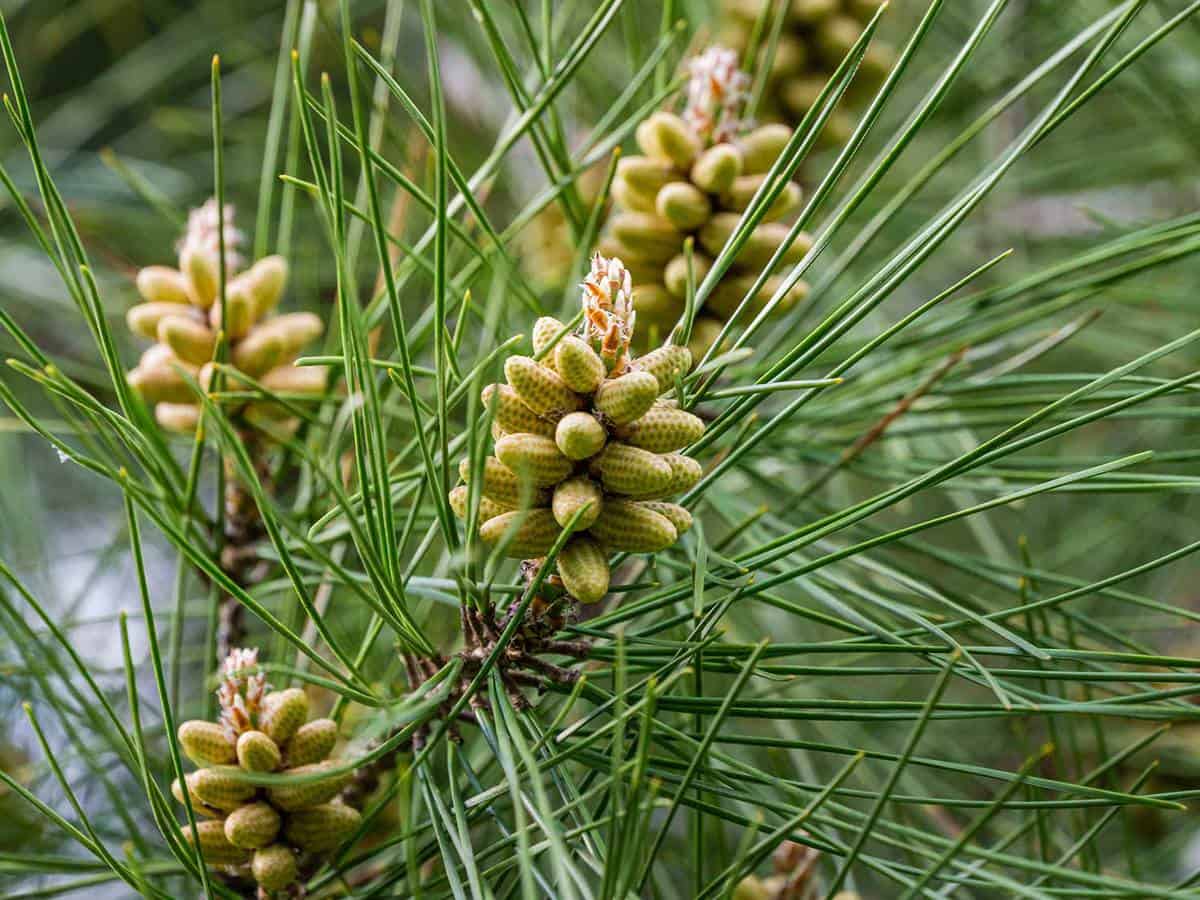Conifers like pine trees have been around since prehistoric times. Although all conifers produce cones, pine trees are of particular interest for their pine cones, seeds, and nuts. If you were curious about whether pine trees produce flowers and what their flowers look like, you might be in for a surprise. We have researched the details of how pine trees reproduce, so you have all the information you need.
Pine trees do not produce flowers because they belong to a class of plants called gymnosperms. Unlike flowering plants, pine trees are unique because they produce naked seeds that are protected by pinecones. Additionally, because pine trees are gymnosperms, they evolved to produce both male and female cones which serve specific purposes to produce future trees. Female pinecones are the only ones with viable seeds which are pollinated from the pollen released by separate male pinecones.
Humans have revered the pine cone for centuries, and both animals and humans have found nutrition and sustenance from pine nuts. The pine tree is quite an exciting type of evergreen because only certain varieties grow pinecones large enough to produce pine nuts that can be harvested. Read on and learn about the pine tree's evolution as a gymnosperm, the stages of pinecones, and revel in a mystery of nature.
The Primordial Pinecone
Flowers protect and hide away the seeds that will produce future plants inside their ovaries. However, the stately and evergreen pine tree produces pinecones to protect their naked seeds without ovaries. The pinecone is truly a marvel of evolution within nature, as gymnosperms are plants that have evolved from plants that rely on spores to reproduce, like moss or ferns. The hardened scales of the female pinecone protect the seeds that await pollination and fertilization, while the male pinecones wait until maturity to release fertilizing spores.
What is a Gymnosperm?
So what exactly is a gymnosperm, and why do pine trees fall under this category? There are two types of seed-bearing plants, gymnosperms, and angiosperms. The word gymnosperm translates to "naked seed," as this type of plant does not have its seeds located within a protective ovary like flowers. The hardened scales of a pinecone serve as an incubator and barrier against the outside world for seeds, keeping them safe from animals, harsh winds, and bitter temperatures. The seeds of a pinecone form on the scales of the structure versus seeds that develop inside an ovary.
The Difference Between Male and Female Pinecones
The development of separate male and female pinecones is a fascinating phenomenon of nature. Male pinecones are smaller than female pinecones, have scales that are closer together, and grow on the lower branches of a mature pine tree. Female pinecones grow on the higher branches of a pine tree, awaiting fertilization and pollination via the release of spores in the air from their male counterpart. When a female pinecone is fertilized, it can take up to a year for a pollen tube to develop and begin the fertilization process and create new seeds from the parent plant.

Pinecones are a welcome source of nutrition, as the pine nuts hidden inside are a source of magnesium, vitamin K, thiamine, and protein. Most pinecones that we see are usually female, as male pinecones are smaller and less noticeable. Sometimes a pine tree will produce male and female pinecones on the same tree, but sometimes they come from separate trees. Male pinecones will release their pollen into the air, where it will drift until it pollinates a female pinecone. Believe it or not, a pinecone can stay on a tree for a decade before it eventually falls.
Pine Nuts
There are multiple types of pine trees, but only one species of pine tree produces the best tasting pine nuts. The Pinyon Pine or Pinus edulis has been prized by Native American people for centuries and is still appreciated today for its culinary value. Other types of pine trees you may encounter include, but are not limited to, the Monterey Pine, Sugar Pine, Lodgepole Pine, and the Coulter Pine. Now that you have become more acquainted with the unique properties of gymnosperms, pinecones, and pine trees, read and discover a few more fine points of interest.
Why is a Pine Tree Not a Flowering Plant?
A pine tree is not a flowering plant because it belongs to a class of plants called gymnosperms, which does not produce seeds within an ovary inside a flower. Instead, pine trees and other conifers are descendants of plants that pollinate using spores. A pine tree produces male and female pinecones to reproduce. Female pine cones consist of hardened scales that help cradle the naked seeds that develop within until they are ready to be fertilized by the spores of male pinecones.
How Do Pine Trees Reproduce?
The seeds of a pin tree are located and develop on the scales of a pinecone. The seeds germinate within the protective pinecone until they are ready to be pollinated and fertilized. Pine trees produce male and female pinecones. The scales of a male pinecone are more tightly knit than the looser harder scales of female pinecones. The male pinecone contains sacks of pollen which release fertilizing spores into the air, which land on female pinecones and create pollen tubes to generate new seeds. It takes years for a pinecone to develop, become fertilized after pollination, and produce seeds.
All conifers produce pinecones, but the pine tree is unique because it takes two years for one of its pinecones to reach maturity. Most conifers produce pinecones that are mature upon fertilization within the same year. Female pinecones only mature and release their seeds once they dry out enough, and the weather is warm enough. Pine trees are not asexual and rely on male pinecones releasing spores that interact with female pinecones.
Check out this pine tree seedling on Amazon.
Check out this bonsai pine tree seed set on Amazon.
How Often Do Pine Trees Produce Pine Cones?
Depending on the type of pine tree you encounter, the time it takes from them to produce pinecones varies. It can take anywhere from two to three years before a pine tree produces pinecones that are fully mature and ready to reproduce. Many pine trees change up how often and when they produce their pinecones to deter predators from readily going after the edible and nutritious seeds hidden inside pinecones. When it is warm enough for pine trees to feel comfortable generating their naked seeds, their pinecones will open up and release the seeds hidden inside.
A pine tree might hold onto its pinecones for a decade or longer until it drops its cones. You can easily find pinecones littered about in forests filled with evergreens during the early summer and within the fall.
What Does a Pine Tree Seed Look Like?
The seeds of a pine tree are relatively vulnerable, as they germinate on the hardened scales of a female pinecone, awaiting maturity so they can be released, pollinated, and fertilized. On average, each scale on a female pinecone will have two seeds. Many pine trees produce seeds within a pinecone that are winged in appearance and look similar to an animal hoof while still attached to the scales. Once a pinecone releases its seeds, it may harder to determine what they are.
Check out this pine tree seed kit on Amazon.
Check out the following articles related to pine trees and develop your green thumb.
6 Types of Compost You Should Know



